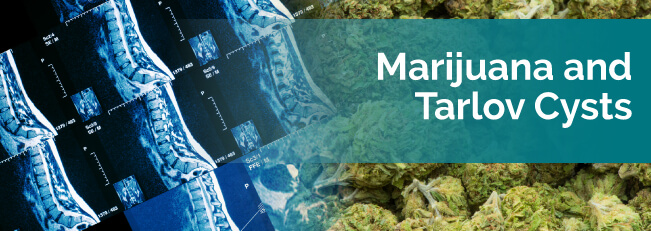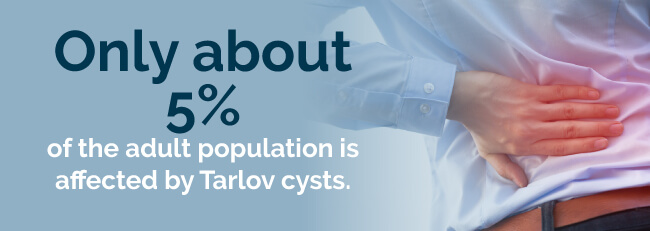
Tarlov cysts affect the spinal cord in the tailbone or sacral region. As the cysts develop, the condition can cause severe pain. Many patients look to cannabis for Tarlov cysts as an alternative treatment option for the pain. Learning more about marijuana and Tarlov cysts can help you decide if this option is right for you
Tarlov cysts are sacs or lesions in the spine in the tailbone or sacral region. The sacral region consists of five sacral vertebrae at the base of the spine right above the tailbone. Spinal fluid fills up the cysts, which can vary in size. Smaller cysts may go undetected, while larger cysts tend to cause more symptoms. Cysts often start small and grow larger and more problematic as the sac fills with spinal fluid. Unlike other cysts that can form in the spine, Tarlov cysts contain nerve fibers within the cyst walls. Its positioning around a nerve root earns it alternative names of perineural or sacral nerve root cyst.
As fluid fills the cysts, the expanding size causes pressure and may compress nerve roots, which can cause a host of symptoms and side effects. The pressure can also cause deterioration of the bones in the area.
The condition, however, is very rare. Only about five percent of the adult population is affected by Tarlov cysts. Women are more likely than men to deal with the condition.

The specific cause of Tarlov cysts is unknown. In some cases, the spinal fluid tends to build up in cysts after an injury to the area or due to extreme exertion, such as lifting something very heavy or giving birth. Other causes may include a fall, a car accident or even an epidural. Some people may already have asymptomatic Tarlov cysts without realizing it when the trauma happens. After the trauma, the patient may begin noticing symptoms of the cysts.
Some researchers believe the cysts are congenital or that they are related to connective tissue disorders. Many patients diagnosed with Tarlov cysts have also been diagnosed with a connective tissue disorder.
The symptoms of Tarlov cysts vary significantly depending on the severity of the cyst. In some cases, a Tarlov cyst doesn’t produce any noticeable symptoms. These minor cases may go undetected. As the cysts grow and expand, they press on the nerve roots, which often causes symptoms to appear. You might first feel pressure and then eventually pain. The symptoms you feel may also vary depending on the exact location of the cyst.
Patients have expressed common symptoms, such as:
The pain associated with a Tarlov cyst may present as an ache in the lower back. Others feel a sciatica-type pain that radiates down through the buttocks and into one leg. The nerve pain associated with the cysts may gradually become worse over time. Some patients feel some relief from the symptoms while lying down. Sitting or standing may cause the pain to increase in severity.
Tarlov cysts are divided into one of four categories based on the severity of the experienced symptoms:
Diagnosis of a Tarlov cyst often happens once the symptoms occur. The doctor may perform a physical exam first. An MRI is an effective way to determine if the source of pain is a Tarlov cyst. The cyst looks like a dilated area or a balloon-like structure in the sacral area of the spinal column.
In other cases, the patient doesn’t have any symptoms but may have an MRI for another reason. During that MRI, the cysts may be discovered. CT scans are sometimes used as part of the diagnosis process, as are myelograms. In these tests, contrast dye is used to get a better look at the structures in the area. Once the dye is injected, the physician uses a CT scan to create the images.
Because of the still unclear pathogenesis of Tarlov Cysts, there has yet to be a consensus on their optimal treatment. Treatment is handled on a case-by-case basis depending on the specific symptoms, cyst location and severity of the case. The medical care team treats the specific symptoms and effects of the cyst to provide as much relief as possible while preventing damage to the spinal cord. In minor cases with few or no symptoms, the patient may receive no treatment at all. The medical team may simply watch the cysts to ensure they don’t grow and cause problems.
Surgery is an option for some patients if the cysts do cause serious pain or other complications. This typically happens when the cysts grow in size and cause significant compression in the spinal cord. Two commonly utilized surgical procedures include the draining and extraction of cerebrospinal fluids from the cyst and the complete or partial removal of the cyst from the area.
If the decision is made to drain the cyst, the procedure can provide relief right away from the pain and pressure. However, the effects are not usually long-lasting. The fluid often begins filling the cyst again after the draining procedure. This can cause the pain and pressure to return.

In cases of severe pain or if the nearby bone begins deteriorating, a more invasive surgery may be required. Surgery for a Tarlov cyst can be particularly risky and complicated. Not only does the surgery take place in the spinal cord, which is risky enough, but it also involves the nerves, which adds to the complexity of the procedure. During the procedure, the surgeon opens the cyst to drain the fluid and remove the nerves from the wall of the cyst. The surgeon then seals the area where the spinal fluid enters the cyst to prevent it from refilling the space.
The surgery can involve a lengthy healing period, especially for the involved nerves. This means the surgery doesn’t always provide immediate pain relief, but the patient may feel better after recovery.
Another option that is sometimes used involves injecting fibrin glue into the cyst. The glue includes several different substances that create an effect similar to blood clotting. The cyst is first drained to remove the spinal fluid that is already inside. The glue is then injected into the area to seal it closed, preventing more spinal fluid from entering the space.
The results of this procedure are mixed. Some patients receive only temporary relief, while others experience longer-lasting relief. Some find relief right away after the procedure. Others find that relief is delayed.
If surgery isn’t an option, many patients with Tarlov cysts rely on medications for pain relief. Oral or injected corticosteroids are sometimes used to treat the pain. These medications come with many potential side effects, including fluid retention, high blood pressure, psychological effects, weight gain, and glaucoma. Non-steroidal anti-inflammatory drugs (NSAIDS) are also used in some patients to help control the pain. Long-term use of NSAIDS can cause stomach ulcers, high blood pressure, leg swelling, and liver or kidney problems.
Another technique used for pain management is Transcutaneous Electrical Nerve Stimulation (TENS). This treatment method involves electrical impulses that travel through the skin and into the nerves to relieve pain. Some patients may experience mild irritation at the site of the electrodes, but otherwise, TENS is a safe option.
For a far less invasive and significantly less risky treatment, medical marijuana can be utilized for pain management. For overall chronic pain relief, medical marijuana is a far safer alternative for a long-term treatment plan. Indica strains can work to relieve headaches and migraines brought about as a result of the cysts. Additionally, medical-grade marijuana can act as a sleep aid for those restless nights.
Specific research on cannabis and Tarlov cysts is limited, in part due to the rarity of the condition. Diseases with higher incident rates often receive more attention in research. Another factor in the limited research is the difficulty in obtaining marijuana for research due to federal regulations and its status as a Schedule I drug.
However, research has been conducted on pain in general and how marijuana works to relieve it. Medical-grade cannabis containing THC has been shown to effectively help neuropathy or peripheral nerve pain. For this reason, choosing a strain of medical cannabis high in THC may help you experience relief from the nerve pain of a Tarlov cyst.

How does marijuana help with pain? It all comes down to how it interacts with your body’s natural endocannabinoid system. This system has receptors throughout the body. Natural endocannabinoids interact with those receptors to keep your body in balance.
Marijuana contains chemicals called cannabinoids. Those chemicals also interact with the receptors in your body. That interaction with the receptors seems to offer pain relief, along with many other benefits of using marijuana. The cannabinoids in marijuana can help create a little more balance in your body.
Marijuana can help other symptoms of Tarlov cysts in addition to the pain, including:
Treating pain from Tarlov cysts with medical cannabis can provide significant relief. Even if you have surgery, you may continue experiencing pain during the recovery process. Because it is effective on all types of pain, including nerve pain, marijuana is worth considering.
When choosing the best strain of marijuana to treat Tarlov cysts, consider the effects you want. Both sativa-dominant and indica-dominant strains are effective in treating pain. If you choose an indica-dominant strain, expect to feel a sleepy, relaxed effect. For sativa-dominant strain users, the marijuana generally creates an energizing, uplifting effect.
Some patients have to do a little experimenting with different strains to find one that is effective. If you don’t get the relief you want or the first strain you try creates side effects you don’t like, consider trying a different strain. Work with your experienced marijuana doctor to select a strain that will best address your Tarlov cyst pain based on your medical history.

When using marijuana for Tarlov cysts, the method of ingestion can also play a role in how effective it is. Explore the methods to determine which one is the best option for your situation. The main options include:
You don’t have to choose just one way to ingest marijuana to treat your Tarlov cyst, though. In many cases, a combination of methods is suitable depending on the time of day and the severity of the pain. You might need the immediate relief of smoking or vaping to manage crippling pain. At bedtime, you may prefer the longevity of edibles. Work with your experienced medical marijuana doctor to create a treatment plan using cannabis.
Marijuana is effective in treating many conditions, particularly those causing pain. The traditional pain relievers used to treat Tarlov cysts come with many potential side effects, including long-term damage to the liver. Marijuana doesn’t have those same dangerous side effects, although it does cause some effects in the body. The side effects of marijuana are generally much milder than effects of pharmaceuticals, however, and once the marijuana wears off, so do the side effects.
Some of the potential side effects include:
If you experience side effects you don’t like, you may simply need to make a few adjustments with your cannabis treatment. For example, you may need a different strain of marijuana. If you don’t like the high sensation, opt for a strain with very little THC. For times when you want to stay alert, use a sativa-dominant strain instead of an indica-dominant strain.
If you suffer from pain due to Tarlov cysts, marijuana may be a natural option for relieving the pain. We can help you connect with qualified marijuana doctors in all legal marijuana states, so you can explore the option of treating a Tarlov cyst with marijuana. Book an appointment, so you can start getting the relief you need from your Tarlov cyst pain.
For more information about how cannabis can be used to treat Tarlov Cysts, check out our resources:
Find A Doctor Find A Dispensary